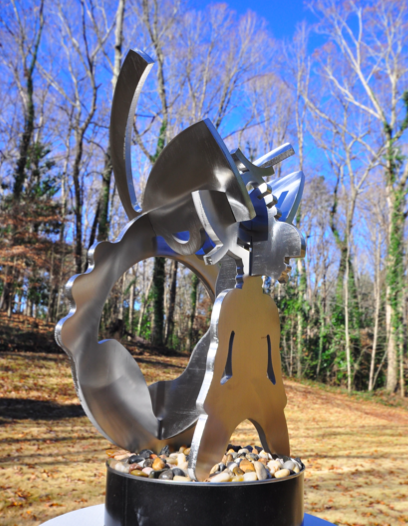
Curtis Patterson, Serenity for Shango
Many of Curtis Patterson’s sculptures have been exhibited at sites both nationally and internationally, which include shows in the United States, France, Nigeria and Sweden. His intrigue with the manipulation of three-dimensional space and objects is clearly evident in many of his massive works, which by virtue of their unique design, invite participation and promote curiosity. Hands on by nature, Patterson enjoys producing large scale works that invite participation rather than impenetrable masses and works that are made inaccessible by some form of barrier. He enjoys his audiences being able to physically access and experience his pieces and frequently embeds subtle surprises within his work as reward for those who are motivated to explore and discover.
An 'unbroken connection' with ancestral lineage is apparent in several of Patterson’s creations from small to large scale works, whose symbolism and elements serve as indelible references to the historical contributions of people of African descent. Patterson pays homage with his sculptures not only to civil rights leaders, musicians, and athletes, but also to those less recognized individuals who have made an equal degree of sacrifice through their social service, domestic work and manual labor.



Serenity for Shango
Serenity for Shango incorporates several elements which are designed to capture the imagination of viewers and pay homage to the lineage of African American culture. It embraces the iconography of African art and the significant contribution and profound impact it has had on modern and contemporary art.
Several elements within the piece draw from key cultural centers of Africa from which many African Americans are descended. As an example, the primary figurative element in the piece is influenced by Shango, a deity of the Yoruba people of Nigeria, whose symbology is believed to imbue both power and energy. Serenity for Shango, introduces a double-iron shape as an analog to the traditional double ax geometry atop the figure head; it is a symbolic element paying homage to those who served in the capacity as domestic laborers for hundreds of years.
The element intersecting Shango is the silhouette of the mask called Nimba. This element is indigenous to the Baga people of Guinea in West Africa and is utilized at Rice Harvest dance ceremonies. The dance is performed in order to produce fertility of the fields. Overarching Nimbi’s head is an Asante (Ashanti) stool which is indigenous to the people of Ghana; it serves as reference to royal and divine symbology of power.
